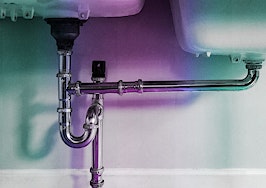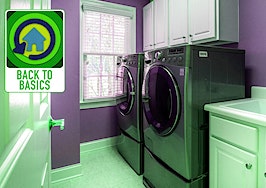Indoor bathing began with the ancient Romans and Greeks with pools fed from aqueducts using lead-lined pipes and underground drainpipes heated by furnaces as early as 75 A.D. Ancient civilizations also had private bathing facilities in their homes, which were the precursor of the modern bathtubs that we know today.
A bathtub is essentially a vessel that holds water provided by two sources — one cool and one hot — with two drains: an overflow outlet at the top of the tub and a trap at the bottom.
Bathtubs have been included in residences since 1842, while showers, by contrast, were built in homes as early as the 1920s, but they became commonplace in the 1940s and 1950s.
In showing houses, a real estate agent will appear very informed and articulate when referring to bathtubs by type. Here are a few important ones to note.
Types of bathtubs
Alcove tubs, placed between two walls at the end of a bathroom or inserted in a three-sided, usually tiled alcove, are the most common type of tub in modern homes.
Freestanding bathtubs can be clawfoot or double-ended pedestal tubs, typically placed in the middle of a larger bathroom or in front of a window for dramatic effect. Drop-in tubs require framing to enclose the tub which can coordinate with cabinetry or tile in the bathroom.
The alcove tub is less expensive and faster to install, as the exterior is already finished. Platform tubs are a type of freestanding tubs but placed on built-up areas of the floor in the bathroom with plumbing underneath.
The newest type of bathtub Realtors may encounter is the walk-in tub, which has a hinged door to allow easy entry and exit. These tubs are usually retrofitted into homes where elderly or handicapped owners rely on them for safe access to bathing.
Walk-in tubs have seats inside and doors that open inward to prevent leaks and ensure that the door will not bump into anything. Nonslip surfaces inside the tubs add safety, and the height of the seat — typically 17 inches — allows for safe bathing.
Newer walk-in tubs have showers included, so you can use a handheld shower while seated. It may be obvious, but unlike a standard bathtub, which you enter after it’s filled with water and can exit before the water is drained, a walk-in tub requires that you enter prior to filling and exit after draining.
Whirlpool tubs and spa tubs became popular in new residential construction in the 1980s and 1990s. Jacuzzi was the company that patented the first whirlpool tub and has since become synonymous with whirlpool or jetted tubs.
Whirlpool is the generic name for any tub with water jets installed. A whirlpool tub features jets that propel water focused on areas of the body that benefit from the effects of hydrotherapy. Usually located on the side of the tub, the jets can be adjusted to where the warm, soothing water may have the greatest benefits.
A variation of the whirlpool tub is the air tub, which has jets and a pump. Rather than water, air is circulated through jets smaller than those in a whirlpool, releasing effervescent bubbles, which are more subtle than water jets. A benefit of air-jetted tubs is the ease of cleaning. After use (after the water has drained), turning on the air jets will dry the lines and prevent mildew.
Jetted tubs require space for the pump, the air switch and the electric timer — which is why these tubs are often found in larger, primary bathrooms or spa baths. The pump can be located remotely but must be within five feet of the tub. The nonelectric air switch must be located on the tub unit. Electric lines must be installed 5 feet from the tub, as designated by code.
Extras and options in a soaking tub include arm or headrests, grab bars and slip-resistant flooring. In addition to adjustable jets, ambient underwater lighting and aromatherapy features can be added to the bathing experience. Some homeowners opt for heated blowers and automated cleaning features.
Recent advances in engineering jetted tubs have made them more popular. These tubs — particularly the larger tubs — fell out of favor as homeowners realized they took a long time to fill with water, and oftentimes, the water would not stay warm long enough to enjoy the bath.
Bathtub materials
Bathtubs are constructed of a variety of materials with porcelain, vitreous china and glazed earthenware being some of the originals. While formed steel with a porcelain enamel coating is the most commonly used bathtub today, plastic and acrylic are less expensive and weigh far less than metal or porcelain.
A plastic tub can weigh as little as 50 pounds, while a cast iron tub can weigh in at over 1,000 pounds when filled with water and a bather. Other materials that Realtors may see in bathtub construction are copper, concrete, stainless steel and other synthetic compositions.
Each tub material has its advantages, and some have major disadvantages. Formed steel tubs conduct heat, and bathwater will cool quickly. Cast iron coated with enamel doesn’t chip as easily because the enamel coating is thicker than on other materials like steel. Cast iron tubs will keep water warm longer.
Synthetics like cast polymer replicates marble, granite and onyx and are pricier than acrylic surfaced bathtubs. Acrylic tubs are formed by heated plastic stretched over a mold, allowing almost endless options for size and shape, requiring a more hands-on process.
Fiberglass bathtubs are constructed by spraying a gelcoat mixture over a mold, a more manufactured process. Gelcoat finishes, used on fiberglass, can become brittle, exposing the material underneath, leading to cracks.
A newer bathtub manufacturing process and material usage is called proprietary composite materials. The composite material is the tub’s infrastructure and enamel covers the infrastructure. The tubs can be one-third the weight of cast iron bathtubs. Proprietary composite tubs have all the benefits of cast iron tubs, with far less weight.
Capacity of hot water heaters
Another topic to discuss with your buyer is the capacity of the hot water heater to service the bathtub. Tubs are ideally filled with 1/3 cold water and 2/3 hot water for pleasant bathing.
It’s important to confirm the hot water heater is capable of filling 2/3 of the bathtub or consider replacing it with a more efficient model.
The size of the tub will determine if sufficient hot water is available. Standard tubs are 60 inches long, 30 inches wide and 14 inches high, and they contain 25 gallons of water. Larger tubs can require as much as 150 gallons to fill.
Real estate agents can intelligently field questions about bathtubs and their variations if they have a few facts at their fingertips. As bathrooms are one of the more renovated rooms in houses and apartments, the age of the property may not be the clear indicator of the type of bathroom and bathtub to be found inside.
Different bathrooms are renovated at different times in the life of a homeowner, and can result in both good and bad features. It is always valuable for a Realtor to be able to discuss all options of houses intelligently.
Gerard Splendore is a licensed associate real estate broker with Warburg Realty in New York. Connect with him on LinkedIn.













